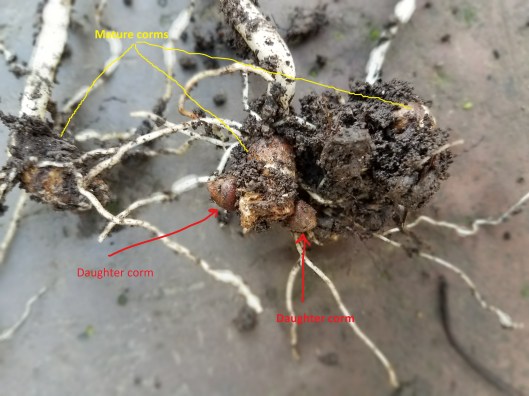Right now is the perfect time to tackle some of our most noxious garden weeds. At Gaiety Hollow, our problem weeds have underground energy storage systems that require them to be dug out.
Fall is a great time to remove these weeds for three reasons:
- After the annuals have been removed and perennial plants have died back, it’s easier to see weeds.
- The moisture in the late fall soil makes it easier to dig and do a thorough job of removal.
- Some weeds are dormant in the summer and re-emerge at this time.
Which weeds plague us the most? I’ll cover our top three nemeses in the next two weeks. First up:

Arum italicum
Arum italicum shows up at this time of year. Its glossy green, arrow-shaped leaves pop up through the garden soil after months of dormancy. In late spring, it flowers, a white-green spadix and spathe reminiscent of a calla lily or peace lily. In late summer, the fruit is red-orange and ornamental. Once you see the pretty green leaves in late autumn and the bright fruit, you understand why someone would grow it as an ornamental. On the other hand, once you see it taking over your shade garden, you will understand why I loath it.

In a garden setting, it seems the only way to remove it is by digging. The leaf has a waxy coating that makes it almost impenetrable by herbicides. Pulling the leaves does not remove the the root structure below the ground–a corm–which stores energy so that if the leaf dies, it can regrow.
Digging seems to be the only way to take down the numbers, BUT you must do it right or you will end up with more plants.
When you dig Arum you have to be very careful. Go deep. As you lift a clump out of the ground, you will notice that there is a corm at the bottom of the leaf. Looking more closely, you may notice many, many more tiny brown daughter corms attached to the large corm (they look almost like a nut). If any one of these falls off, it becomes a new plant. This is the reason why some people say that digging Arum only produces more plants.

My recommendation? Dig out Arum in clumps, put the corms and attached dirt directly into a garbage bag, tie the bag, and dispose of it in the garbage. You do not want to put the corms in compost (it will not get hot enough to kill the corms). Don’t try removing the dirt from the clump; you will unwittingly spread the minuscule daughter tubers. All of it should go in the trash.

Corms disguised by dirt. Can you see the brown “daughter” corm in the center?


Unfortunately, you are not going to get out all the corms your first year tackling Arum. This is a multi-year eradication project. I’m on year two at Gaiety Hollow.
My second recommendation? Buy a new house with no Arum in the yard.
I’m only half kidding!
Whatever you do, do not introduce this plant to your garden. If you have Arum in your yard, assume that any plant you dig up could be contaminated and do not give it away to unsuspecting friends.
More information from the City of Portland and the National Park Service.
Next week, this little terror.



pretty leaves but consider us warned. we have our own battles with ivy not planted in our yard but burrowing in from yards around us. and, i might add, even though reputable nurseries sell aspens DO NOT PLANT one. we have four! and little shoots pop up all over our garden. eager to hear about next week’s “little terror”. it looks familiar.
Argggh. Thanks Lindsey…we (sadly) have arum and can’t move.
Thank you for this- it’s very helpful!
________________________________
Wow, and I sort of like the way they look. Guess I may have some digging to do. I await the next insights.
Digging the soil knife! Is it from am Leonard?
Indeed it is. One of my favorite tools
I agree with that! I actually work at AM Leonard, so I was curious if it was ours or another brand. So hard working there because I feel like half my check goes into the garden or stocking up on stuff lol